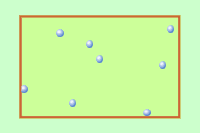Q1+2. The diagram shows gas molecules trapped in a container. The molecules (particles) are moving very fast. they collide with the walls of the container producing a pressure. |
 |
|||||||||||
1. Which of these statements best describes the effect of this pressure on the container?
|
||||||||||||
2. If the container volume is increased, without changing the temperature of the gas, what happens to pressure of the gas?
|
||||||||||||
3-6. A simple experiment is carried out using a gas syringe: A pressure sensor is attatched to the end of the syringe, and the pressure reading taken as the gas volume is reduced. The reading is taken after a while to allow the temperature to remain constant. The results are shown in the green table below. The formula linking pressure and volume is: p V = constant |
Database Center for Life Science (DBCLS) |
|||||||||||
3. What are the likely missing volume units labelled X in the results table below?
|
||||||||||||
4-6. What are the missing values in the results table for the syringe shown here?
|
||||||||||||
7. Which of these statements best describes what happens to a gas trapped inside a bicycle pump when it is pushed inwards rapidly, reducing the volume of the gas?
|
||||||||||||
8+9: When divers go deep under water the pressure increases, as per this formula: Pressure (Pa) = height (m) x density (kg/m3) x g (N/kg) What are the missing values in this table used for divers in a lake? (Density of water= 1000 kg/m3)
|
||||||||||||